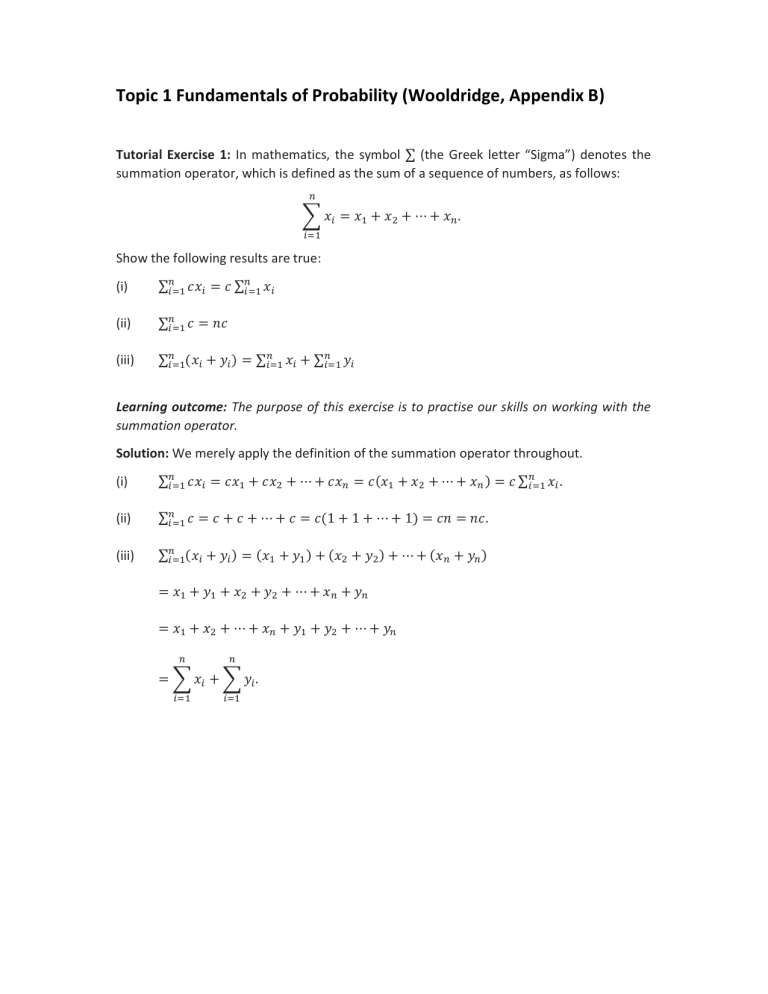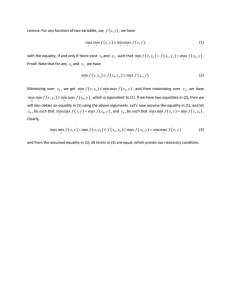
Topic 1 Fundamentals of Probability (Wooldridge, Appendix B) Tutorial Exercise 1: In mathematics, the symbol ∑ (the Greek letter “Sigma”) denotes the summation operator, which is defined as the sum of a sequence of numbers, as follows: 𝑥 = 𝑥 +𝑥 +⋯+ 𝑥 . Show the following results are true: (i) ∑ 𝑐𝑥 = 𝑐 ∑ (ii) ∑ 𝑐 = 𝑛𝑐 (iii) ∑ (𝑥 + 𝑦 ) = ∑ 𝑥 𝑥 +∑ 𝑦 Learning outcome: The purpose of this exercise is to practise our skills on working with the summation operator. Solution: We merely apply the definition of the summation operator throughout. (i) ∑ 𝑐𝑥 = 𝑐𝑥 + 𝑐𝑥 + ⋯ + 𝑐𝑥 = 𝑐(𝑥 + 𝑥 + ⋯ + 𝑥 ) = 𝑐 ∑ (ii) ∑ 𝑐 = 𝑐 + 𝑐 + ⋯ + 𝑐 = 𝑐(1 + 1 + ⋯ + 1) = 𝑐𝑛 = 𝑛𝑐. (iii) ∑ (𝑥 + 𝑦 ) = (𝑥 + 𝑦 ) + (𝑥 + 𝑦 ) + ⋯ + (𝑥 + 𝑦 ) = 𝑥 + 𝑦 +𝑥 +𝑦 +⋯+ 𝑥 +𝑦 = 𝑥 + 𝑥 + ⋯+ 𝑥 + 𝑦 + 𝑦 +⋯+ 𝑦 = 𝑥 + 𝑦. 𝑥. Tutorial Exercise 2: Let 𝑌 and 𝑋 be two discrete random variables. Prove the following results: (i) (ii) (iii) (iv) (v) (vi) (vii) For any constant 𝑐, 𝐸(𝑐) = 𝑐. For any constants 𝑎 and 𝑏, 𝐸(𝑎𝑋 + 𝑏) = 𝑎𝐸(𝑋) + 𝑏. 𝐸(𝑌|𝑋) = 𝐸(𝑌) if 𝑌 and 𝑋 are independent. For any constant 𝑐, 𝑉𝑎𝑟(𝑐) = 0 For any constants 𝑎 and 𝑏, 𝐸(𝑎𝑋 + 𝑏𝑌) = 𝑎𝐸(𝑋) + 𝑏𝐸(𝑌). 𝑉𝑎𝑟(𝑎𝑋 + 𝑏𝑌) = 𝑎 𝑉𝑎𝑟(𝑋) + 𝑏 𝑉𝑎𝑟(𝑌) + 2𝑎𝑏𝐶𝑜𝑣(𝑋, 𝑌). 𝐶𝑜𝑣(𝑎𝑋, 𝑏𝑌) = 𝑎𝑏𝐶𝑜𝑣(𝑋, 𝑌). Learning outcome: The purpose of this exercise is to deepen our understanding on the properties of the expectation operator (expected value), the variance and the covariance. Hint: Given a random discrete random variable 𝑋, let 𝑔(𝑋) be a new discrete random variable, for some real-valued function 𝑔(. ). Make use of the definition of the expected value of 𝑔(𝑋), which is given by 𝐸[𝑔(𝑋)] = 𝑔(𝑥 )𝑓(𝑥 ) + 𝑔(𝑥 )𝑓(𝑥 ) + ⋯ + 𝑔(𝑥 )𝑓(𝑥 ) = 𝑔 𝑥 𝑓 𝑥 . Since (i) is a special case of (ii), you may complete (ii) first. Solution: We apply the above formula repeatedly. In particular, (i) let 𝑔(𝑋) = 𝑐 + 𝛼𝑋 = 𝑐 + 0𝑋 = 𝑐, where 𝛼 = 0. We have 𝐸[𝑔(𝑋)] = 𝑔(𝑥 )𝑓(𝑥 ) + 𝑔(𝑥 )𝑓(𝑥 ) + ⋯ + 𝑔(𝑥 )𝑓(𝑥 ) = (𝑐 + 𝛼𝑥 )𝑓(𝑥 ) + (𝑐 + 𝛼𝑥 )𝑓(𝑥 ) + ⋯ + (𝑐 + 𝛼𝑥 )𝑓(𝑥 ) = (𝑐 + 0𝑥 )𝑓(𝑥 ) + (𝑐 + 0𝑥 )𝑓(𝑥 ) + ⋯ + (𝑐 + 0𝑥 )𝑓(𝑥 ) = 𝑐𝑓(𝑥 ) + 𝑐𝑓(𝑥 ) + ⋯ + 𝑐𝑓(𝑥 ) = 𝑐[𝑓(𝑥 ) + 𝑓(𝑥 ) + ⋯ + 𝑓(𝑥 )] =𝑐 𝑓 𝑥 = 𝑐, where the last equality holds because ∑ 𝑓 𝑥 𝑃(𝑋 = 𝑥 ) + 𝑃(𝑋 = 𝑥 )+. . . +𝑃(𝑋 = 𝑥 ) = 1. (ii) = 𝑓(𝑥 ) + 𝑓(𝑥 ) + ⋯ + 𝑓(𝑥 ) = Let 𝑔(𝑋) = 𝑎𝑋 + 𝑏. We have 𝐸[𝑔(𝑋)] = 𝑔(𝑥 )𝑓(𝑥 ) + 𝑔(𝑥 )𝑓(𝑥 ) + ⋯ + 𝑔(𝑥 )𝑓(𝑥 ) = (𝑎𝑥 + 𝑏)𝑓(𝑥 ) + (𝑎𝑥 + 𝑏)𝑓(𝑥 ) + ⋯ + (𝑎𝑥 + 𝑏)𝑓(𝑥 ) = 𝑎𝑥 𝑓(𝑥 ) + 𝑏𝑓(𝑥 ) + 𝑎𝑥 𝑓(𝑥 ) + 𝑏𝑓(𝑥 ) + ⋯ + 𝑎𝑥 𝑓(𝑥 ) + 𝑏𝑓(𝑥 ) = 𝑎𝑥 𝑓(𝑥 ) + ⋯ + 𝑎𝑥 𝑓(𝑥 ) + 𝑏𝑓(𝑥 ) + ⋯ + 𝑏𝑓(𝑥 ) =𝑎 𝑥 𝑓 𝑥 +𝑏 𝑓 𝑥 = 𝑎𝐸(𝑋) + 𝑏. (iii) We have 𝑓 | (𝑦|𝑥) = 𝑓 , (𝑥, 𝑦) 𝑓 (𝑥)𝑓 (𝑦), = = 𝑓 (𝑦). 𝑓 (𝑥) 𝑓 (𝑥) Where the second equality is due to the fact that 𝑌 and 𝑋 are independent. Therefore, 𝐸(𝑌|𝑋 = 𝑥) = 𝑦 𝑓 | (𝑦 |𝑥) + 𝑦 𝑓 | (𝑦 |𝑥) + ⋯ + 𝑦 𝑓 | (𝑦 |𝑥) = 𝑦 𝑓 (𝑦 ) + 𝑦 𝑓 (𝑦 ) + ⋯ + 𝑦 𝑓 (𝑦 ) = (iv) 𝑦𝑓 𝑦 = 𝐸(𝑌). Let 𝑔(𝑋) = 𝑐 + 0𝑋 = 𝑐 ⇒ [𝑔(𝑋)] = 𝑐 . The variance of 𝑔(𝑋) is given by 𝑉𝑎𝑟[𝑔(𝑋)] = 𝐸[𝑔(𝑋) ] − 𝐸 𝑔(𝑋) We have already shown that 𝐸 𝑔(𝑋) = 𝑐 ⇒ 𝐸 𝑔(𝑋) . = 𝑐 . On the other hand, 𝐸[𝑔(𝑋) ] = [𝑔(𝑥 )] 𝑓(𝑥 ) + [𝑔(𝑥 )] 𝑓(𝑥 ) + ⋯ + [𝑔(𝑥 )] 𝑓(𝑥 ) = 𝑐 𝑓(𝑥 ) + 𝑐 𝑓(𝑥 ) + ⋯ + 𝑐 𝑓(𝑥 ) =𝑐 ∴ 𝑉𝑎𝑟(𝑐) = 𝑐 − 𝑐 = 0. 𝑓 𝑥 =𝑐 . (v) Let 𝑔(𝑋, 𝑌) = 𝑎𝑋 + 𝑏𝑌. We have 𝐸[𝑔(𝑋, 𝑌)] = 𝑎𝑥 + 𝑏𝑦 𝑓 , 𝑥 ,𝑦 , = =𝑎 𝑎𝑥 + 𝑏𝑦 𝑓 𝑥 𝑓 =𝑎 , 𝑥 ,𝑦 + 𝑏 𝑥 𝑓 (𝑥 ) + 𝑏 𝑥 ,𝑦 , 𝑦 𝑓 , 𝑥 ,𝑦 𝑦𝑓 𝑦 = 𝑎𝐸(𝑋) + 𝑏𝐸(𝑌), where the second-to-last equality is due to the Law of Total Probability, which states that ∑ 𝑓 , 𝑥 , 𝑦 = 𝑓 (𝑥 ) and ∑ 𝑓 , 𝑥 , 𝑦 = 𝑓 (𝑦 ). (vi) We have 𝑉𝑎𝑟(𝑎𝑋 + 𝑏𝑌) = 𝐸 (𝑎𝑋 + 𝑏𝑌) − 𝐸 (𝑎𝑋 + 𝑏𝑌) = 𝐸[𝑎𝑋 + 𝑏𝑌 − 𝑎𝐸(𝑋) − 𝑏𝐸(𝑌)] = 𝐸 𝑎 𝑋 − 𝐸(𝑋) + 𝑏 𝑌 − 𝐸(𝑌) = 𝐸 𝑎 𝑋 − 𝐸(𝑋) =𝑎 𝐸 𝑋 − 𝐸(𝑋) + 𝑏 𝑌 − 𝐸(𝑌) +𝑏 𝐸 𝑌 − 𝐸(𝑌) + 2𝑎𝑏 𝑋 − 𝐸(𝑋) 𝑌 − 𝐸(𝑌) + 2𝑎𝑏𝐸 𝑋 − 𝐸(𝑋) 𝑌 − 𝐸(𝑌) = 𝑎 𝑉𝑎𝑟(𝑋) + 𝑏 𝑉𝑎𝑟(𝑌) + 2𝑎𝑏𝐶𝑜𝑣(𝑋, 𝑌), where the second equality is due to part (v) of this exercise, whereas the fourth equality is due to the binomial theorem, or otherwise (𝑎 + 𝑏) = (𝑎 + 𝑏)(𝑎 + 𝑏) = 𝑎 + 𝑎𝑏 + 𝑏𝑎 + 𝑏 = 𝑎 + 𝑎𝑏 + 𝑎𝑏 + 𝑏 = 𝑎 + 2𝑎𝑏 + 𝑏 . (vii) We have 𝐶𝑜𝑣(𝑎𝑋, 𝑏𝑌) = 𝐸 𝑎𝑋 − 𝐸(𝑎𝑋) 𝑏𝑌 − 𝐸(𝑏𝑌) = 𝐸 𝑎𝑋 − 𝑎𝐸(𝑋) 𝑏𝑌 − 𝑏𝐸(𝑌) = 𝐸 𝑎 𝑋 − 𝐸(𝑋) 𝑏 𝑌 − 𝐸(𝑌) = 𝑎𝑏𝐸 𝑋 − 𝐸(𝑋) 𝑌 − 𝐸(𝑌) = 𝑎𝑏𝐶𝑜𝑣(𝑋, 𝑌). where the second and fourth equalities are due to part (ii) of this exercise.

